2009 Hyundai Elantra trailer
[x] Cancel search: trailerPage 205 of 308

543
Driving your vehicle
If you do decide to pull a trailer
Here are some important points if you
decide to pull a trailer:
Consider using a sway control. You canask a towbar dealer about sway con- trol.
Do not do any towing with your car dur- ing its first 2,000 km in order to allow
the engine to properly break in. Failure
to heed this caution may result in seri-
ous engine or transaxle damage.
When towing a trailer, be sure to con- sult an authorised Hyundai dealer for
further information on additional
requirements such as a towing kit, etc.
Always drive your vehicle at a moder- ate speed (less than 100 km/h).
On a long uphill grade, do not exceed 30 km/h with 2 people in the car or the
posted towing speed limit, whichever is
lower.
The important considerations have to do with weight:
500 (1102)
1200 (2645)
75 (165)
1085 (42.7)Maximum trailer weight kg (lbs.)
Maximum permissible static vertical load on
the coupling device kg (lbs.)
Recommended distance from rear wheel centre to coupling point mm (inch)
Without brake System
With brake System
Page 206 of 308
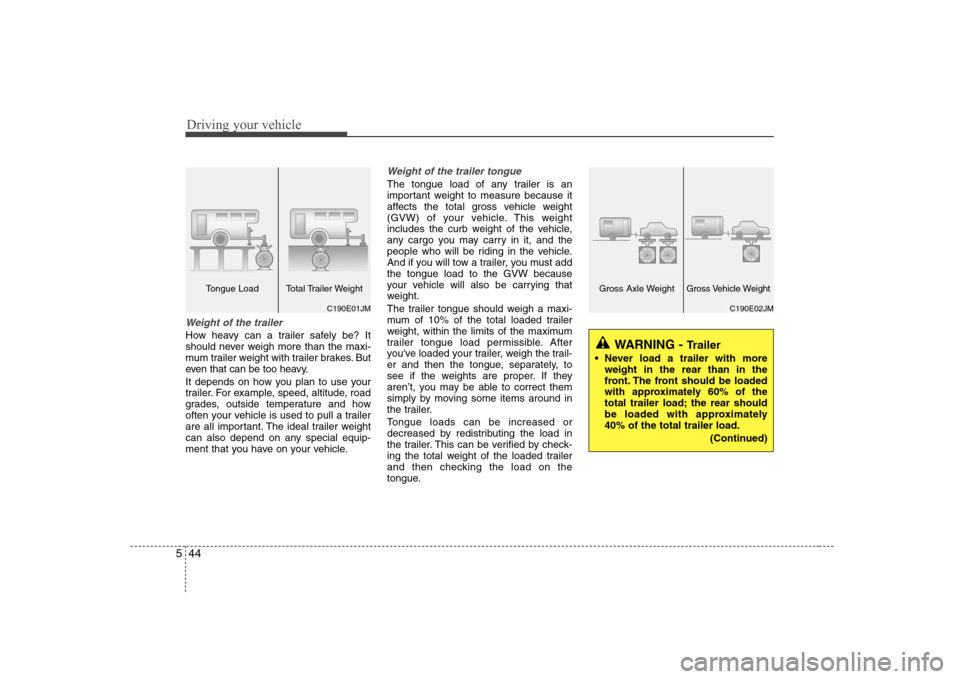
Driving your vehicle
44
5
Weight of the trailer
How heavy can a trailer safely be? It
should never weigh more than the maxi-
mum trailer weight with trailer brakes. But
even that can be too heavy.
It depends on how you plan to use your
trailer. For example, speed, altitude, road
grades, outside temperature and how
often your vehicle is used to pull a trailer
are all important. The ideal trailer weight
can also depend on any special equip-
ment that you have on your vehicle.
Weight of the trailer tongue
The tongue load of any trailer is an
important weight to measure because it
affects the total gross vehicle weight
(GVW) of your vehicle. This weight
includes the curb weight of the vehicle,
any cargo you may carry in it, and the
people who will be riding in the vehicle.
And if you will tow a trailer, you must addthe tongue load to the GVW because
your vehicle will also be carrying that
weight.
The trailer tongue should weigh a maxi-
mum of 10% of the total loaded trailer
weight, within the limits of the maximum
trailer tongue load permissible. After
you've loaded your trailer, weigh the trail-
er and then the tongue, separately, to
see if the weights are proper. If they
aren’t, you may be able to correct them
simply by moving some items around in
the trailer.
Tongue loads can be increased or
decreased by redistributing the load in
the trailer. This can be verified by check-
ing the total weight of the loaded trailer
and then checking the load on the
tongue.
WARNING - Trailer
Never load a trailer with more weight in the rear than in the
front. The front should be loaded
with approximately 60% of the
total trailer load; the rear should
be loaded with approximately40% of the total trailer load.
(Continued)
C190E02JM
Gross Axle WeightGross Vehicle Weight
C190E01JM
Tongue Load Total Trailer Weight
Page 207 of 308
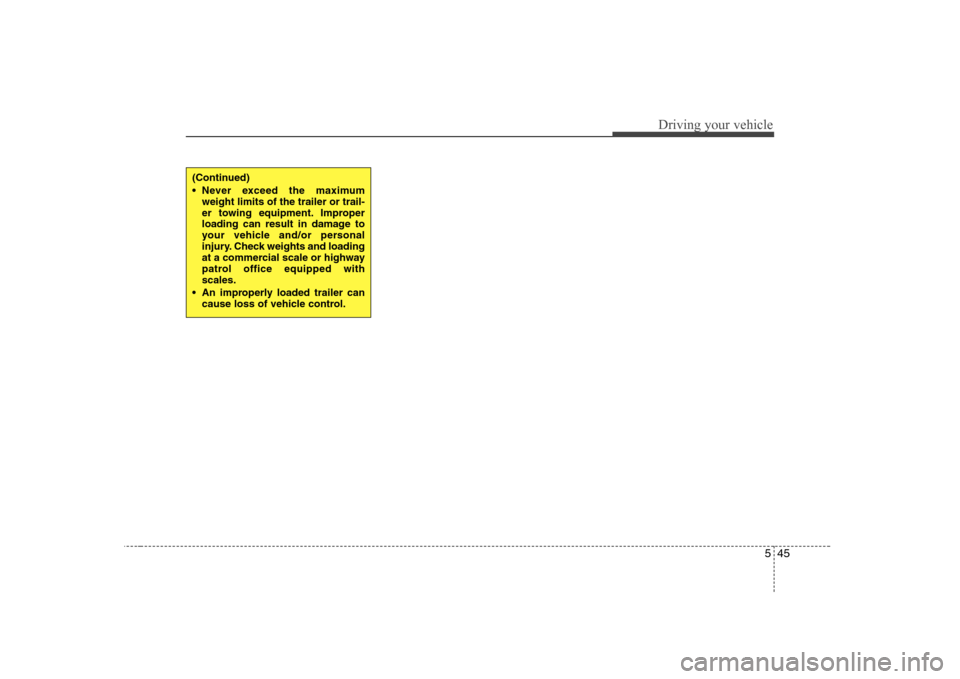
545
Driving your vehicle
(Continued)
Never exceed the maximumweight limits of the trailer or trail-
er towing equipment. Improper
loading can result in damage to
your vehicle and/or personal
injury. Check weights and loading
at a commercial scale or highway
patrol office equipped withscales.
An improperly loaded trailer can cause loss of vehicle control.
Page 208 of 308
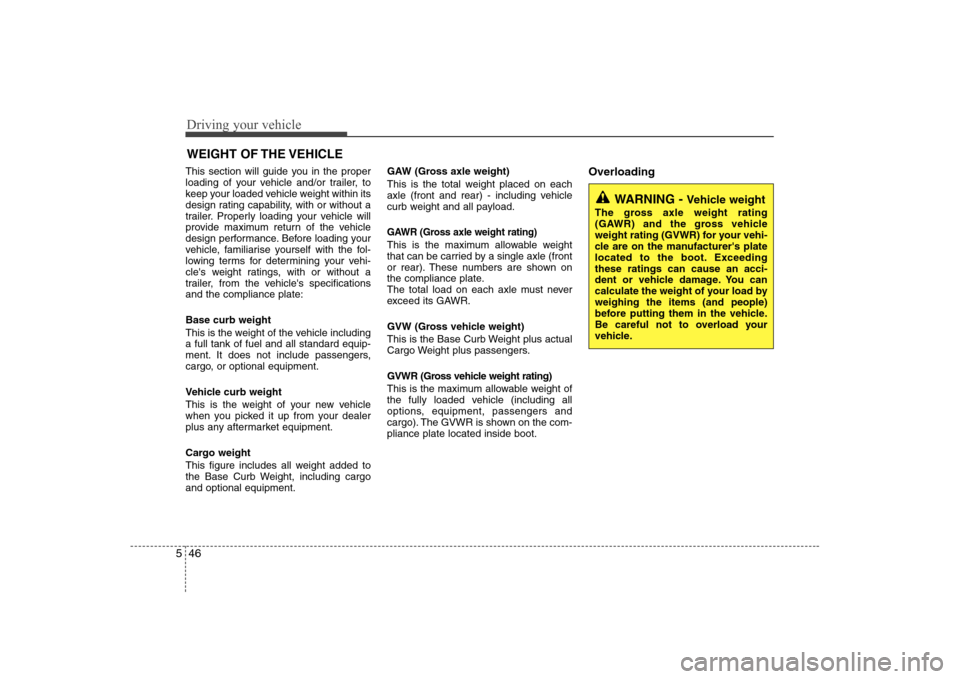
Driving your vehicle
46
5
This section will guide you in the proper
loading of your vehicle and/or trailer, to
keep your loaded vehicle weight within its
design rating capability, with or without a
trailer. Properly loading your vehicle will
provide maximum return of the vehicle
design performance. Before loading your
vehicle, familiarise yourself with the fol-
lowing terms for determining your vehi-
cle's weight ratings, with or without a
trailer, from the vehicle's specificationsand the compliance plate: Base curb weight
This is the weight of the vehicle including a full tank of fuel and all standard equip-
ment. It does not include passengers,
cargo, or optional equipment.
Vehicle curb weight
This is the weight of your new vehicle
when you picked it up from your dealer
plus any aftermarket equipment.
Cargo weight
This figure includes all weight added to
the Base Curb Weight, including cargoand optional equipment. GAW (Gross axle weight)
This is the total weight placed on each
axle (front and rear) - including vehicle
curb weight and all payload.
GAWR (Gross axle weight rating)
This is the maximum allowable weight
that can be carried by a single axle (front
or rear). These numbers are shown on
the compliance plate.
The total load on each axle must never
exceed its GAWR.
GVW (Gross vehicle weight)
This is the Base Curb Weight plus actual
Cargo Weight plus passengers.
GVWR (Gross vehicle weight rating)
This is the maximum allowable weight of
the fully loaded vehicle (including all
options, equipment, passengers and
cargo). The GVWR is shown on the com-pliance plate located inside boot.
Overloading
WEIGHT OF THE VEHICLE
WARNING -
Vehicle weight
The gross axle weight rating
(GAWR) and the gross vehicle
weight rating (GVWR) for your vehi-
cle are on the manufacturer's plate
located to the boot. Exceedingthese ratings can cause an acci-
dent or vehicle damage. You can
calculate the weight of your load byweighing the items (and people)
before putting them in the vehicle.
Be careful not to overload your
vehicle.
Page 221 of 308
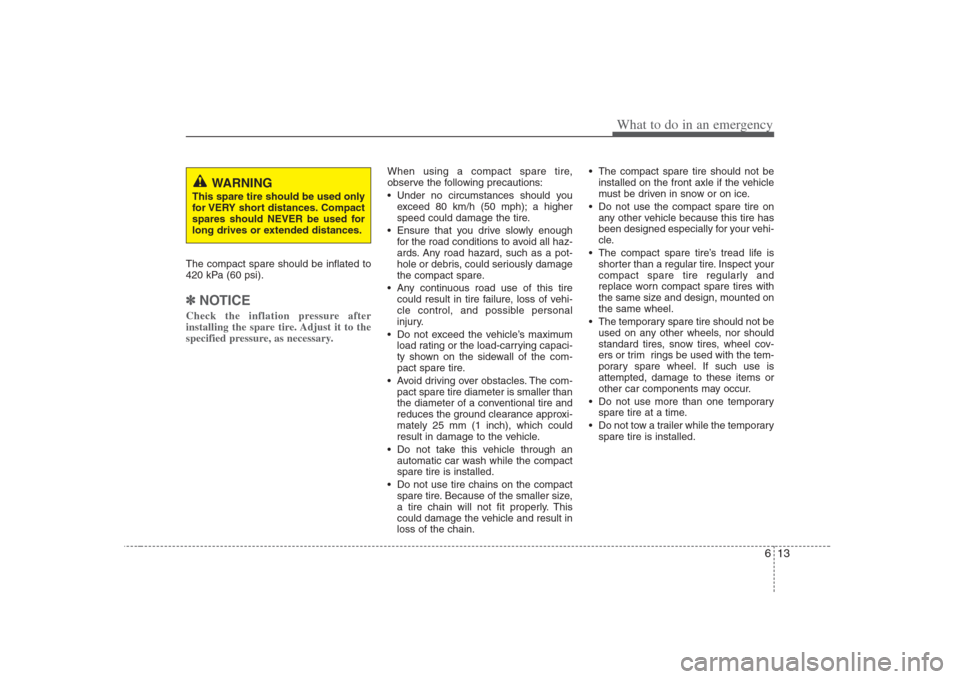
613
What to do in an emergency
The compact spare should be inflated to
420 kPa (60 psi).
✽✽NOTICE
Check the inflation pressure after
installing the spare tire. Adjust it to the
specified pressure, as necessary.
When using a compact spare tire,
observe the following precautions:
Under no circumstances should you exceed 80 km/h (50 mph); a higher
speed could damage the tire.
Ensure that you drive slowly enough for the road conditions to avoid all haz-
ards. Any road hazard, such as a pot-
hole or debris, could seriously damage
the compact spare.
Any continuous road use of this tire could result in tire failure, loss of vehi-
cle control, and possible personal
injury.
Do not exceed the vehicle’s maximum load rating or the load-carrying capaci-
ty shown on the sidewall of the com-
pact spare tire.
Avoid driving over obstacles. The com- pact spare tire diameter is smaller than
the diameter of a conventional tire and
reduces the ground clearance approxi-mately 25 mm (1 inch), which could
result in damage to the vehicle.
Do not take this vehicle through an automatic car wash while the compactspare tire is installed.
Do not use tire chains on the compact spare tire. Because of the smaller size,
a tire chain will not fit properly. This
could damage the vehicle and result inloss of the chain. The compact spare tire should not be
installed on the front axle if the vehicle
must be driven in snow or on ice.
Do not use the compact spare tire on any other vehicle because this tire has
been designed especially for your vehi-
cle.
The compact spare tire’s tread life is shorter than a regular tire. Inspect your
compact spare tire regularly and
replace worn compact spare tires with
the same size and design, mounted onthe same wheel.
The temporary spare tire should not be used on any other wheels, nor should
standard tires, snow tires, wheel cov-
ers or trim rings be used with the tem-
porary spare wheel. If such use isattempted, damage to these items or
other car components may occur.
Do not use more than one temporary spare tire at a time.
Do not tow a trailer while the temporary spare tire is installed.
WARNING
This spare tire should be used only
for VERY short distances. Compact
spares should NEVER be used for
long drives or extended distances.
Page 222 of 308
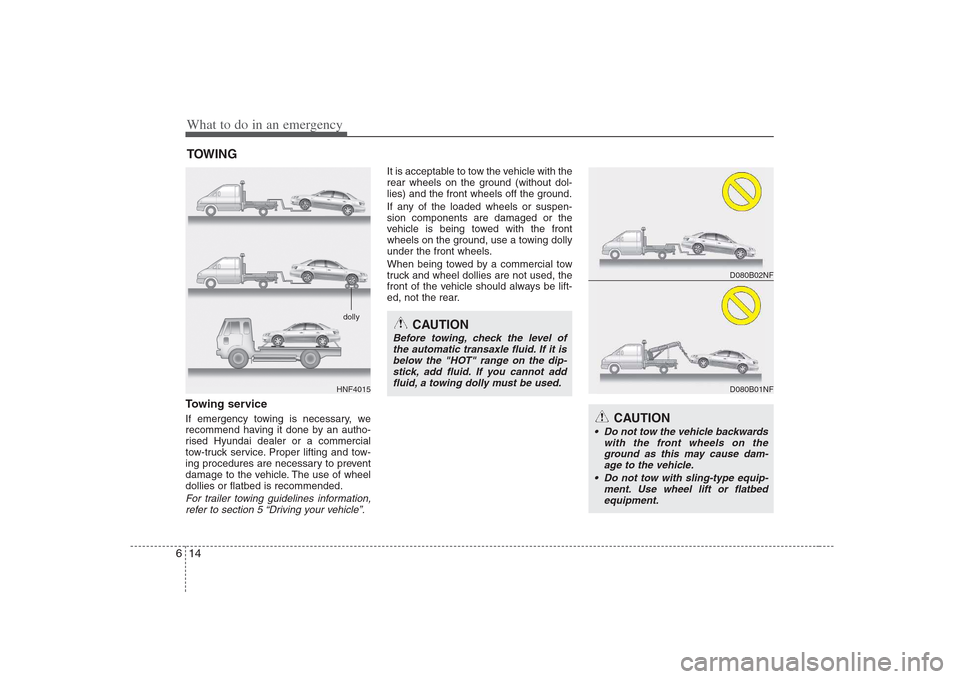
What to do in an emergency
14
6
TOWING
Towing service
If emergency towing is necessary, we
recommend having it done by an autho-
rised Hyundai dealer or a commercial
tow-truck service. Proper lifting and tow-
ing procedures are necessary to prevent
damage to the vehicle. The use of wheeldollies or flatbed is recommended.
For trailer towing guidelines information, refer to section 5 “Driving your vehicle”.
It is acceptable to tow the vehicle with the
rear wheels on the ground (without dol-
lies) and the front wheels off the ground.
If any of the loaded wheels or suspen- sion components are damaged or the
vehicle is being towed with the front
wheels on the ground, use a towing dolly
under the front wheels.
When being towed by a commercial tow
truck and wheel dollies are not used, the
front of the vehicle should always be lift-
ed, not the rear.
HNF4015
D080B02NF
D080B01NF
CAUTION
Do not tow the vehicle backwards
with the front wheels on theground as this may cause dam-age to the vehicle.
Do not tow with sling-type equip- ment. Use wheel lift or flatbed
equipment.
CAUTION
Before towing, check the level ofthe automatic transaxle fluid. If it isbelow the "HOT" range on the dip- stick, add fluid. If you cannot addfluid, a towing dolly must be used.
dolly
Page 237 of 308
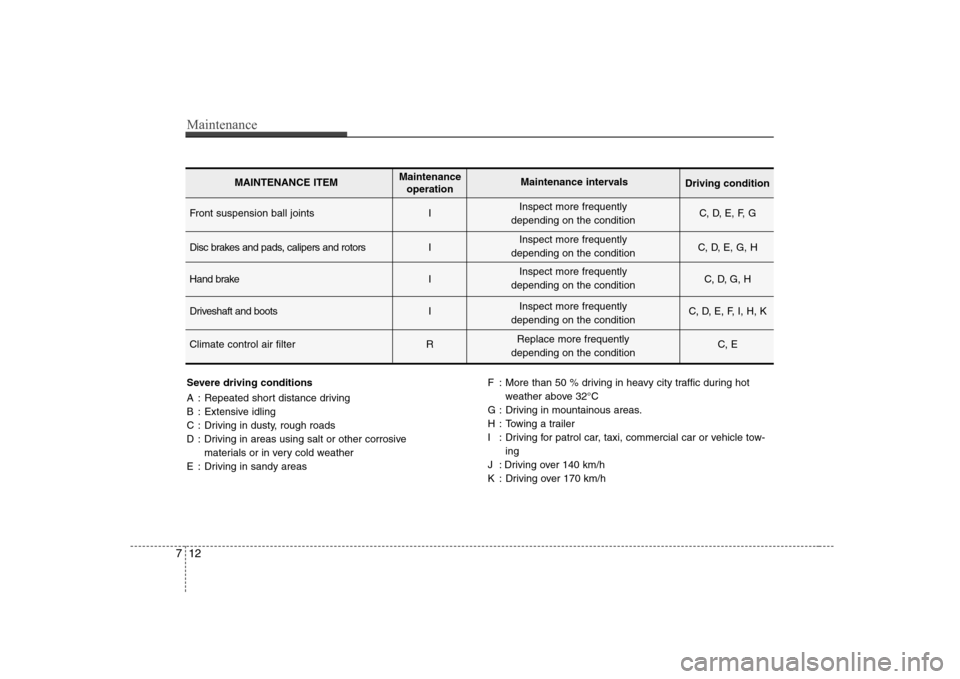
Maintenance
12
7
Severe driving conditions
A : Repeated short distance driving
B : Extensive idling
C : Driving in dusty, rough roads
D : Driving in areas using salt or other corrosive
materials or in very cold weather
E : Driving in sandy areas F : More than 50 % driving in heavy city traffic during hot
weather above 32°C
G : Driving in mountainous areas.
H : Towing a trailer
I : Driving for patrol car, taxi, commercial car or vehicle tow- ing
J : Driving over 140 km/h
K : Driving over 170 km/h
Front suspension ball joints I C, D, E, F, G
Disc brakes and pads, calipers and rotors I C, D, E, G, H
Hand brake I C, D, G, H
Driveshaft and boots I C, D, E, F, I, H, K
Climate control air filter R C, E
MAINTENANCE ITEMMaintenance
operation Maintenance intervals
Driving condition
Inspect more frequently
depending on the condition
Inspect more frequently
depending on the condition
Inspect more frequently
depending on the condition
Inspect more frequently
depending on the condition
Replace more frequently
depending on the condition
Page 308 of 308
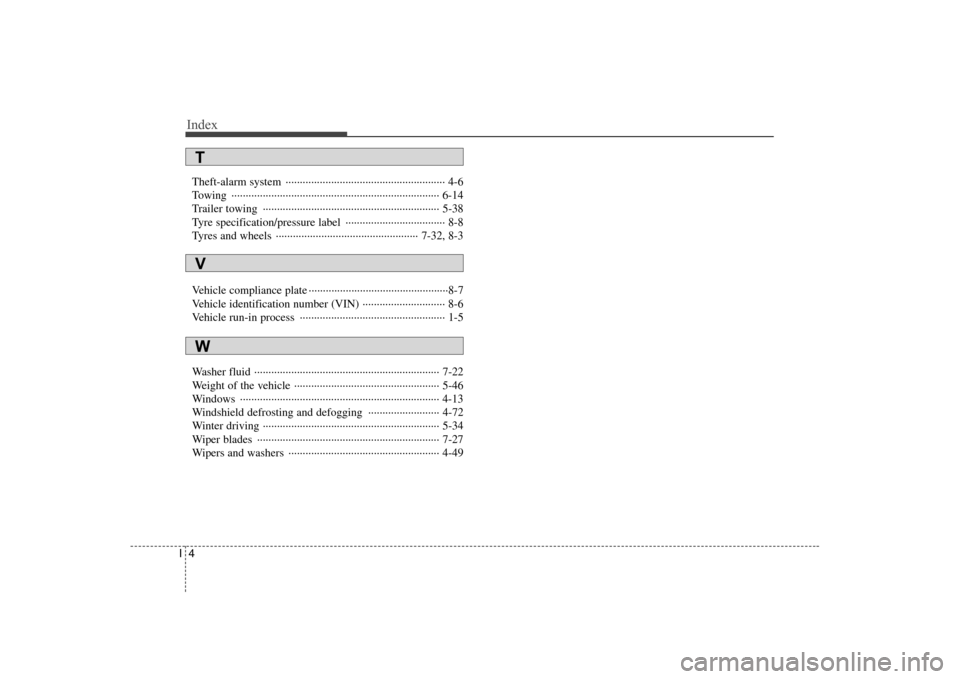
Index
4I
Theft-alarm system ························································ 4-6
Towing ········································································· 6-14
Trailer towing ······························································ 5-38
Tyre specification/pressure label ··································· 8-8
Tyres and wheels ·················································· 7-32, 8-3
Vehicle compliance plate ·················································8-7
Vehicle identification number (VIN) ····························· 8-6
Vehicle run-in process ··················································· 1-5
Washer fluid ································································· 7-22
Weight of the vehicle ··················································· 5-46
Windows ······································································ 4-13
Windshield defrosting and defogging ························· 4-72
Winter driving ······························································ 5-34
Wiper blades ································································ 7-27
Wipers and washers ····················································· 4-49
V
W
T